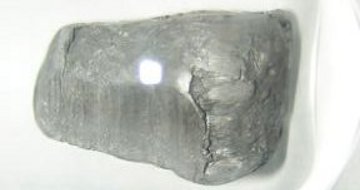
Thallium
Thallium General
| Name:Thallium | Symbol:Tl |
| Type:other Metal | Atomic weight:204.37 |
| Density @ 293 K:11.85 g/cm3 | Atomic volume:17.2 cm3/mol |
|
Discovered:
Thallium was discovered spectroscopically in l861 by William Crookes. The metal was isolated both by William Crookes and by Claude-Auguste Lamy in 1862. The element name comes from the Greek word 'thallos' meaning a green shoot or twig, after the green spectral line which identifies the element. |
|
Thallium States
| State (s, l, g):solid | |
| Melting point:577 K (304 °C) | Boiling point:1746 K (1473 °C) |
Thallium Energies
| Specific heat capacity:0.13 J g-1 K-1 | Heat of atomization:182 kJ mol-1 |
| Heat of fusion:4.142 kJ mol-1 | Heat of vaporization :164.10 kJ mol-1 |
| 1st ionization energy: 589.4 kJ mol-1 | 2nd ionization energy:1971 kJ mol-1 |
| 3rd ionization energy:2878 kJ mol-1 | Electron affinity:36 kJ mol-1 |
Thallium Oxidation & Electrons
| Shells:2,8,18,32,18,3 | Electron configuration: [Xe] 4f14 5d10 6s2 6p1 |
| Minimum oxidation number:0 | Maximum oxidation number:3 |
| Min. common oxidation no.:0 | Max. common oxidation no.:3 |
| Electronegativity (Pauling Scale): 1.83 | Polarizability volume:7.6 Å3 |
Thallium Appearance & Characteristics
| Structure:hcp: hexagonal close pkd | Color:silvery-gray |
| Hardness:1.2 mohs | |
|
Harmful effects:
Thallium and its compounds are highly toxic. Agatha Christie made use of thallium's toxicity in her novel The Pale Horse. One symptom the victims experienced, including one of the amateur investigators, was that their hair came out in clumps. |
|
|
Characteristics:
Thallium is a very soft, malleable, lustrous low-melting, silvery metal that tarnishes in air to the bluish-gray oxide. In appearance it resembles lead. The metal can easily be cut with a knife. In the presence of water, the poisonous thallium hydroxide (TlOH) is formed. Thallium dissolves slowly in hydrochloric acid and dilute sulfuric acid and dissolves rapidly in nitric acid. Uses: Thallium sulfate, which is odorless and colorless, was used as a rat poison and as an insecticide. This use has been discontinued in some countries, including the USA. Thallium sulfide is used in photocells because its electrical conductivity increases on exposure to infrared light. Thallium oxide is used to make glass that has a high index of refraction. Thallium is also used in gamma radiation detection equipment. |
|
Thallium Reactions
| Reaction with air:mild, ⇒ Tl2O | Reaction with 6 M HCl: |
| Reaction with 15 M HNO3: mild ⇒ TlNO3 | Reaction with 6 M NaOH: |
Thallium Compounds
| Oxide(s):Tl2O, Tl2O3 | Chloride(s):TlCl, TlCl2, TlCl3 |
| Hydride(s): |
Thallium Radius
| Atomic radius:190 pm | Ionic radius (1+ ion):164 pm |
| Ionic radius (2+ ion):pm | Ionic radius (3+ ion):102.5 pm |
| Ionic radius (2- ion):pm | Ionic radius (1- ion):pm |
Thallium Conductivity
| Thermal conductivity:46.1 W m-1 K-1 | Electrical conductivity:5.6 x 106 S m-1 |
Thallium Abundance & Isotopes
| Abundance earth's crust:850 parts per billion by weight, 80 parts per billion by moles | |
| Abundance solar system:1 part per billion by weight, 10 parts per trillion by moles | |
| Cost, pure:$48 per 100g | |
| Cost, bulk: $ per 100g | |
|
Source:
The main minerals containing thallium are crookesite (TlCu 7Se 4), hutchinsonite (TlPbAs 5S 9), and lorandite (TlAsS 2). Thallium also occurs in manganese nodules on the ocean floor. Commercially, the metal is recovered as a by-product of sulfuric acid production as thallium is also present in pyrites (iron sulfide). Thallium can also be obtained from< |
|
|
Isotopes:
Thallium has 31 isotopes whose half-lives are known, with mass numbers from 179 to 210. Of these, two are stable: 203Tl and 205Tl. Naturally the most common isotope is 205Tl, with an abundance of 70.5%. |
|
Thallium Other
|
Other:
|
|
Prev: Mercury Next: Lead |